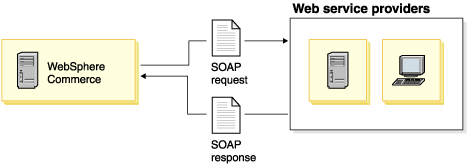WebSphere Commerce as a service consumer

Service invocation
When WebSphere Commerce acts as a service consumer, a component client API will be called from your task command. The client API will use the invocation service and the invocation service will require a deployed configuration file to determine how to communicate with the remote component. Each component will have a separate configuration file to configure the client API. Each store can also have a version of the configuration file that will take precedence over the default configuration. This allows the store to override some or the entire configuration without changing the default configuration.
For additional information, see Customizing the web service client invocation XML file
Messaging system
WebSphere Commerce uses its messaging subsystem to invoke web services on external systems. The client API will use a WebSphere Commerce message type, which will carry the service request to its destination over the specified transport. To see the mappings provided by default, see Outbound service message mappings enabled for service-oriented integration.
Web Service over HTTP Connector
This connector will send Web service requests over HTTP. The web service HTTP JCA connector will wrap the web service request message inside a SOAP envelope and allow the security credentials to be specified. The additional SOAP header information will be interaction specification properties associated with the web service JCA configuration. The JCA will set these properties when constructing the SOAP message. Additionally, this connector will throw exceptions when SOAP faults are returned as part of the service request.
As a feature of this particular connector, when an exception occurs when executing the request based on the connection properties, this connector will wait a specified period of time before allowing the same request to execute again. This prevents the backend system from being flooded with a series of requests when it is unavailable or unresponsive. Certain communication exceptions will be caught and cached and assigned a timeout value. When requests based on the same connection information are made, the cached exception will be thrown instead of executing the request. When the timeout expires, the request will be made as usual. The purpose of this is to provide the caller with an exception while trying to avoid making repeated requests to a backend system that currently is not responding.
Web Service over JMS Connector
The web service JMS JCA is an extension of the current JMS messaging JCA connector that will wrap the message inside a SOAP envelope and allow security credentials to be specified. This connector throws exceptions when SOAP faults are returned as part of the service request.
Further recommendations
For complex service definitions, such as OAGIS documents that utilize complex XSD features of the XML specification, the recommended approach for Web service client development is to leverage the Eclipse Modeling Framework (EMF) tooling and capabilities offered by the Rational Application Developer. A demonstration of using this alternative for developing Web service clients is described in this article, Developing Web Services with EMF SDOs for complex XML.